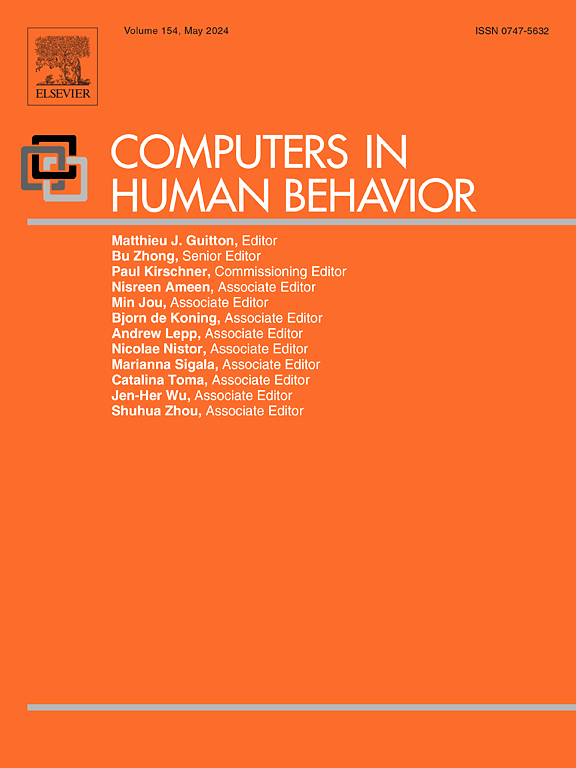是什么让中国青少年沉迷于智能手机?利用网络分析法和三波纵向分析法评估不良童年经历对智能手机成瘾的影响
IF 9
1区 心理学
Q1 PSYCHOLOGY, EXPERIMENTAL
引用次数: 0
摘要
研究发现,不良童年经历与智能手机成瘾之间存在密切联系。然而,很少有研究探讨了各种智能手机应用成瘾之间的密切联系及其并发性。为了填补这一空白,本研究采用了一项试点研究和两项正式研究来探讨不同智能手机应用成瘾的并发性及其潜在风险因素和内在机制。在试点研究(N = 118)中,对有智能手机成瘾的青少年进行了访谈,以确定他们经常使用的应用程序和内容类型。在研究 1(N = 1962)中,利用网络分析法评估了智能手机成瘾这一更广泛范畴内的六种应用偏好,以及童年不良经历与智能手机成瘾之间的潜在关系效应。在研究 2(N = 835)中,通过纵向研究进一步验证了这一因果关系,研究还发现,亚历山大症和社会敏感性在智能手机应用添加中起到了中介作用。中心度最高的应用程序是短视频,其次是游戏,再次是社交媒体应用程序。此外,研究还发现一系列与暴力有关的社会经历(如忽视和欺凌)是智能手机成瘾的关键决定因素,因为这些经历会增加青少年的情感障碍和社会敏感性,从而阻碍他们的社会化进程,导致他们对智能手机如痴如醉。这项研究的结果有助于更好地理解不良童年经历是如何增加青少年使用智能手机成瘾的风险的,同时也为了解各种常见智能手机应用软件成瘾的并发症提供了新的视角。本文章由计算机程序翻译,如有差异,请以英文原文为准。
What makes Chinese adolescents glued to their smartphones? Using network analysis and three-wave longitudinal analysis to assess how adverse childhood experiences influence smartphone addiction
Research has identified a robust connection between adverse childhood experiences and smartphone addiction. However, few studies have explored the close links between various smartphone application addictions and their co-occurrence. To bridge this gap, the current study used one pilot study and two formal studies to explore the co-occurrence of different smartphone application addictions, as well as their potential risk factors and internal mechanisms. In the pilot study (N = 118), adolescents with smartphone addictions were interviewed to determine their regularly-used applications and content type. In Study 1 (N = 1962), network analysis was used to assess six application preferences within the broader umbrella of smartphone addiction, and the potential relationship effect between adverse childhood experiences and smartphone addiction. In Study 2 (N = 835), the causal relationship was further verified through a longitudinal study which also found that alexithymia and social sensitivity played mediating roles in smartphone application addition. The application addiction with the highest centrality was for short videos, followed by games and then social media applications. In addition, a range of social experiences associated with violence (e.g., neglect and bullying) were found to be key determinants of smartphone addiction, in that these experiences hinder adolescents' socialization by increasing their alexithymia and social sensitivity, leading them to become glued to their smartphones. The findings of this study contribute to a better understanding of how adverse childhood experiences increase adolescents’ risk of smartphone addiction, while also providing new insights into the co-occurrence of addictions to various common smartphone applications.
求助全文
通过发布文献求助,成功后即可免费获取论文全文。
去求助
来源期刊

Computers in Human Behavior
Multiple-
CiteScore
19.10
自引率
4.00%
发文量
381
审稿时长
40 days
期刊介绍:
Computers in Human Behavior is a scholarly journal that explores the psychological aspects of computer use. It covers original theoretical works, research reports, literature reviews, and software and book reviews. The journal examines both the use of computers in psychology, psychiatry, and related fields, and the psychological impact of computer use on individuals, groups, and society. Articles discuss topics such as professional practice, training, research, human development, learning, cognition, personality, and social interactions. It focuses on human interactions with computers, considering the computer as a medium through which human behaviors are shaped and expressed. Professionals interested in the psychological aspects of computer use will find this journal valuable, even with limited knowledge of computers.
 求助内容:
求助内容: 应助结果提醒方式:
应助结果提醒方式:


